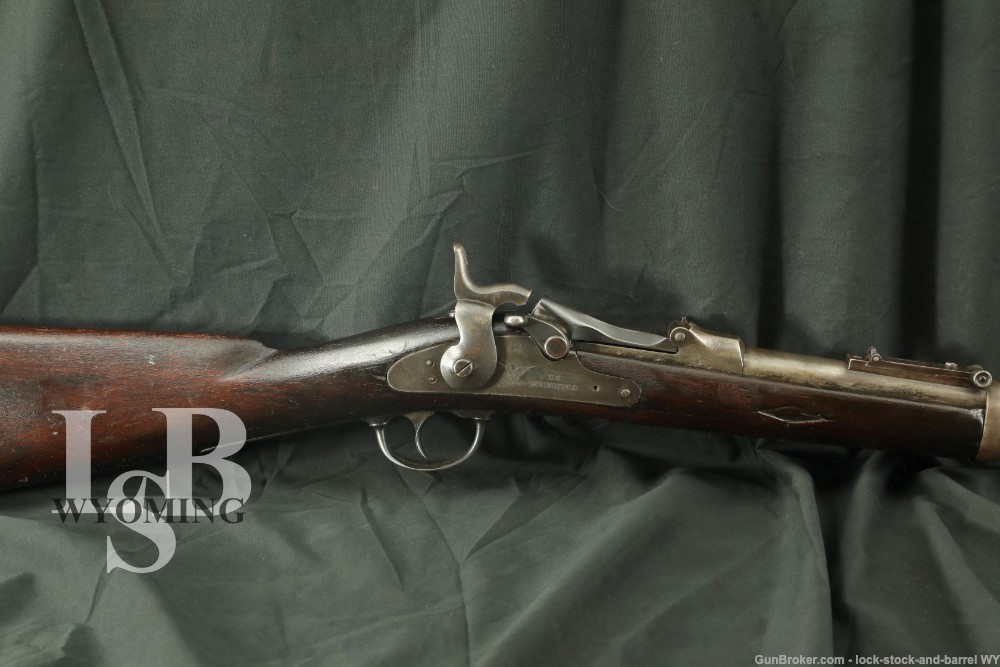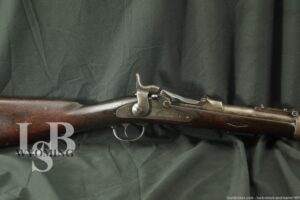
U.S. Springfield M1873 Trapdoor Carbine .45-70 Single Shot Rifle, Antique
SOLD FOR: $1,235.00
WOA#: WY240323WM011
Make: United States Armory and Arsenal at Springfield
Model: Model 1873 Trapdoor Carbine, Saddle ring
Serial Number: 187813
Year of Manufacture: 1882, July-September
Caliber: .45-70 (Black powder)
Action Type: Trapdoor, single shot
Markings: The rear of the breech is marked “187813”. The top of the action is marked “U.S Model 1873”. The lock plate is marked with a federal eagle and “U.S. Springfield”. The left side of the barrel is marked “VP P”. The right side of the barrel band is marked “U”. The heel of the buttplate is marked “US.”
Barrel Length: 22”
Sights / Optics: The front sight is a blade set into a barrel mounted base. The rear sight is a Buffington style rear sight.
Stock Configuration & Condition: The wood stock has a straight wrist, barrel band, two lock plate screws, trigger guard mounted sling loop, saddle ring bar with saddle ring, and metal buttplate with a storage compartment. The buttplate has pitting and light oxidation throughout. There are compression marks, scuffs, and scratches throughout the wood. There are small chips throughout the wood. There are cracks forming at the top of the buttplate. There are spots in the wood where some inlay was once present. The LOP measures 13.5” from the front of the trigger to the back of the buttplate. The stock rates in about Good overall condition for an antique.
Type of Finish: Blued
Finish Originality: Original
Bore Condition: The bore is dark and the rifling is worn. There is moderate erosion and pitting in the bore. In this writer’s opinion, this bore rates 5/10.
Most antique firearms have bores that will show erosion. This is not only due to age but to the use of black powder. When fired, black powder reacts corrosively. NRA Antique Firearm Conditions Standards are quite lenient for bores. In some cases, the NRA standards disregarded the bore’s condition for collectors’ firearms.
Overall Condition: This rifle retains about 10% of its metal finish. The inside of the action and top of the tang/trapdoor retains some bluing. The rest of the bluing has either worn off or turned to patina. There is light pitting at the stockline. The bottom of the trigger guard has a layer of rust. The saddle ring is in good condition. The screw heads show moderate use. Overall, this rifle rates in about Good condition as an antique.
Mechanics: The action functions correctly. The rifle has a half-cock safety. We did not fire this rifle. As with all used firearms, a thorough cleaning may be necessary to meet your maintenance requirements.
Box, Paperwork & Accessories: None
Our Assessment: The U.S. Springfield M1873 Trapdoor Carbine is a pivotal firearm in American military history, particularly in the context of the post-Civil War period and the Indian Wars. It represents a significant evolution in rifle design and usage by the U.S. Army. The M1873 Trapdoor Carbine, a shortened version of the M1873 rifle, was designed and manufactured by the Springfield Armory in Springfield, Massachusetts. It was adopted by the U.S. Army in 1873 and remained in service into the late 19th century. The carbine was specifically intended for use by cavalry troops, given its shorter length and lighter weight compared to the standard rifle, making it easier to handle on horseback. Chambered in .45-70 Government, a cartridge developed by the U.S. military, the M1873 carbine featured a 22-inch barrel, compared to the 32-inch barrel of the rifle version. The .45-70 round was known for its stopping power and effectiveness at medium ranges, which was crucial for cavalry engagements. The carbine used a single-shot, breech-loading mechanism known as the “trapdoor” system. This mechanism involved a hinged breechblock that opened upwards and forward, allowing for quick loading and unloading of cartridges. The simplicity and reliability of this system were significant advantages in the field. The M1873 Trapdoor Carbine is perhaps best known for its use during the Indian Wars, most notably in the Battle of the Little Bighorn in 1876, where Lieutenant Colonel George Armstrong Custer and his troops, armed with these carbines, faced the combined forces of the Lakota, Northern Cheyenne, and Arapaho tribes.
The Springfield M1873 Trapdoor Carbine represents an important transitional period in U.S. military firearms, bridging the gap between muzzle-loading rifles and more modern repeating arms. Its use of the .45-70 Government cartridge set a standard for military ammunition for years to come. Today, the M1873 Trapdoor Carbine is highly valued by collectors and historians for its historical significance and its role in the western expansion and military history of the United States. -R.E.



